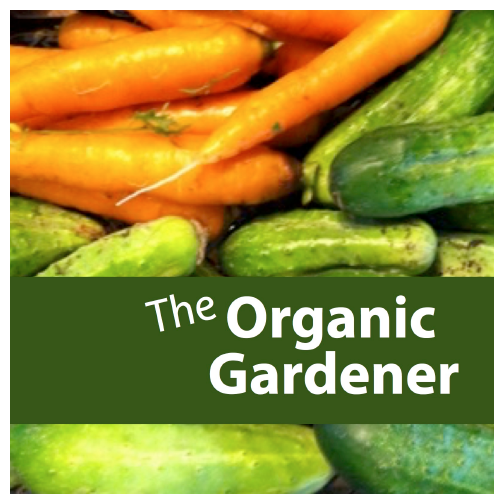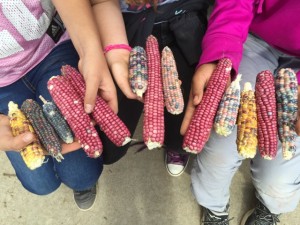106. Regan Emmons | Terra Birds School Gardens & a Seedling CSA| Flagstaff, AZ
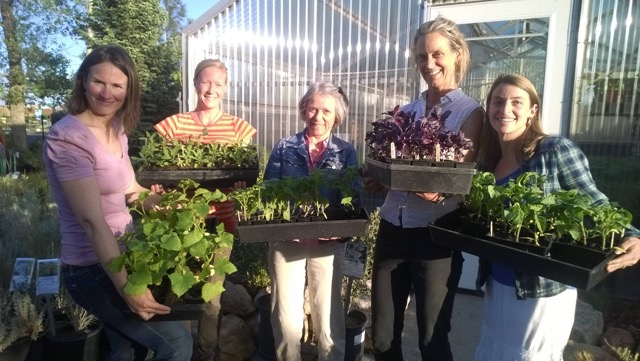
Terra BIRDS educates and empowers youth through gardening to help prepare them as the stewards of a sustainable future for humanity. Regan Emmons is here to share her story of teaching elementary and high school students how to garden as well as about her seedling CSA model!
Tell us a little about yourself.
My first podcast! So very exciting!
I live in Flagstaff, AZ, I have really awesome job very fortunate to work with elementary school students, high school students and I run a 100 member seedling CSA farm, that runs about Jan through the end 0f May. The rest of the year I’m doing a lot of planning and educating and so forth.
Tell me about your first gardening experience?
I am from Tennessee. One of my formative experiences of being in a garden, working in a garden, I was in high school and I was living with my mother. We had to move into s small apartment on the ground floor. And my mother being the tenacious woman she is, talked the landlord into tilling up the little space in the back of our apartment. She grew mostly tomatoes and peppers and if she grew other things I don’t remember, but the tomatoes were amazing and I just remember’d them for so long. They were big and juicy and ripe and a revelation! I just remember my friends would come over in summer and we would make these tomato sandwiches. I remember leaning over the sink was this beautiful memory that I have
that my mother grew in this tiny space
wasn’t mind blowing
I thought everyone did that and
later
amazing how productive wasn’t even, wasn’t even 10 square feet. And I didn’t really help her very much, I was one of those teenagers who didn’t really care about helping my mother.
I didn’t help my mom either, she’s still wondering how I ended up with a gardening podcast I’m sure. My husband wonders that too, but I definitely help him more then my mom.
What does organic gardening/earth friendly mean to you?
I believe in my realm it really means growing without adding a lot of things, pesticides and chemicals and really trying to work on soil amendments and soil health and to let that dictate the health of the plants. I feel like it really has to come with the soil and I’ve learned that through my work with the garden starts.
using fertilizers sparingly, and the fertilizers you do use need to be well sourced from natural sources, I really really dislike synthetic sources. I really don’t like to use them at all. To me, organic gardening is not using additives and working with the space that you have, definitely have some permaculture training, it’s all part of that gardening sensibility.
Who or what inspired you to start using organic techniques?
Back when I was living in Hawaii, and I met my husband there. I was working in Hawaii, on the island of Maui. I met my husband there and we were getting to know each other. He came from a place and a family where they really cared about what they put into their body. I grew up caring about what I put in my body, but not really thinking about the food and what was in the food that I was eating. I didn’t really think about additives in my meat, and things like that. And it really stemmed from that, learning about food system and our industrial food system, and that was a challenging place to eat anymore. If we weren’t trying to grow our own food or trying to eat more locally, it was really detrimental.
How did you learn how to garden organically?
I read a lot, I’m still learning, I consider myself a novice gardener and novice grower. But in my career, I have had a lot of jobs where I grew things. In Hawaii I grew a lot of native plants at my job at the park service. As a community gardener here in Flagstaff, working with other people in the garden a lot! Great mentors along the way. Worked one on one with business management end of things, helping with the watering, from my mentors who offered a lot, in my current job, picked up a lot from my coworkers.
I’m curious to learn about your job at the park service because work is always the best way to meet your spouse and then also the Park Service has my favorite commercial out, if you can have a favorite commercial.
I am, I always had an interest in plants, had been working in Tennessee, working on invasive plant issues, my boyfriend at the time, I went sort of following him he went to Hawaii first, I really needed a change and needed to get out of dodge. I had a family connection, my mother grew up in Oahu, I always wanted to visit, and never thought I’d actually live there, but it just worked out. I applied for a job before I got there, met the guy who would be my future boss, and we got along really well, I went out into the field with him on volunteer basis and did a couple of volunteer trips with the group I ended up working with for 7 years.
I was really lucky, and lucky was able to get a job. I also had some undergrad experience with propagation, working on an American Chestnut trees and I had a lot of really good references and I really wanted that job and worked really hard to get that job and tried really hard and got it!
That’s interesting because my guest right before you Anna Peach is from Hawaii and also I found you because Bill McDorman talked about your seedling CSA so I wanted to hear about that too but I also want to hear about the schools so which every you want to talk about first!
2016 will be the 5th year that I managed it. This is kind of an opportunity that fell into my hands. This Garden Starts CSA Started by a business here called Flagstaff Native Plant seed.
They really had a heart for the program and wanted it to continue but didn’t want to do the work, it’s a lot of work, and with all they were doing it was just too much for them. So they approached a non-profit called Flagstaff Food-Link, and I was on the board and still am of Flagstaff Food- Link. So they approached us because they needed a non-profit partner so with this business, they worked together to see how it would work out and if it would work?
That year I was not involved with the CSA, I was just involved with Food Link, but after the first year, the grower didn’t want to continue growing. So they approached me, would you like to run with this? And I said sure this sounds amazing! Food Link really wanted to bring in the community more and have them help with the sowing, and a lot more help with operations
CSA also community
members and volunteers from community at large where able to participate in it. Before that nobody had brought volunteers into this arena.
They had a grower who was in charge of the green house, I was in charge of finding volunteers. The CSA had always had 60 members so I was charged with the task of getting 100 members!
That sounds like a lot!
first year was a lot of fun, learned a lot,
grower at the time, I’m still really good friends with! We made a lot of mistakes, but we also made a lot of decisions so that was a success that year. I’ve been doing it ever since 2012! We’ve changed growers around, but I’ve been still involved, it’s one of the most amazing experiences I’ve ever had! We have volunteers who still come back, and often members as well! We involved students form Northern AZ university, and students from terra birds.
high school students
give seeds for direct sewing as part of the CSA share. I get to meet all kind of people and it’s just been really fun! A person I went to grad school with owns a compost company, so we use some of their soil for some of our seedling mix! He was also the same person went to go look at land that is for sale in Flagstaff that was preciously farmed for years, we actually did have an agricultural economy here in Flagstaff that was mostly beans and potatoes. He went to look at this land, spoke to widow of the Walter Brandeis. Walter grew pinto beans, and she said I have this really old bag of pinto beans and it turned out to be this 50 lb. bag of pinto beans, he started getting them out in the community.
I was excited because I wanted someone to grow a fresh batch of them I could distribute them to the CSA. So Patrick got the word out, asked the community if any one can grow out some seeds, I will pay market price for them. I want to give fresh seed, I didn’t know how old the seeds were but we wanted to give members fresh seed. Sure enough I had a backyard grower grow out the beans, and he gave me about 5lbs which is more then enough to give our members for 2016. So we are going to be able to grow beans that have been grown here for decades!
It’s really excited side projects have come out of this
really fulfilling and exciting
program itself now operates through terra birds
So how does it work? What do you grow?
A Seedling CSA
The growing season in Flagstaff is incredibly short! We are sitting at 7000 feet, not like the rest of Arizona, in some places the growing season is 60 days, in some neighborhoods. It’s very diverse in some micro-climates, the mountains here in Flagstaff really changes and in season temps.
if they are really interested in growing and having food gardens, and vegetables, they need to get their starts from somewhere. A lot of people grow their own in side but a lot of people don’t have the space etc. Like in my house I can’t start don’t have enough south facing exposure, and I don’t want to buy a light machine. So the options were before the CSA you would go to the nursery and buy vegetable seedlings
They weren’t grown here so to
nothing agains CALI but it’s not Flagstaff not always appropriate for Flagstaff, not grown here at this elevations,
To get a plant a cold hardy variety, that might be drought tolerant and all these other things are going to be a lot more successful in your garden,
thorough native plants seeds
Kim Costion, has been doing it even longer, and we’re all friends here and we all get ideas from each other. We start registering members in January, we start growing thousands of seedlings. A share consists of about 120 plants, we do everything from kale to tomatillos seedlings! We did tomatillos for the first time this year!
We distribute at the end of April, which is early for here, and then our last distribution day right before Memorial day weekend, which is actually a little early for some things, but people can coddle their seedlings if they want to for a little bit, they don’t have to plant it that weekend.
We will distribute the cold hardy stuff at the end of April, warm season things like tomatoes at the last pickup
Last frost day is June 10th
pretty late
We like to say it gives Flagstaff gardens a jump start!
If you we’re to plant a tomato seeds on June 10th you’re probably not gonna get tomatoes, by the time they start to get ready to produce it’s gonna be getting cold already. So it’s pretty much a necessity here in Flagstaff, you gotta get the starts from somewhere.
You could if you don’t want to how much is a share?
offering
It changes every year but it’s about $100 a share.
Wow that’s a great deal!
So about 3 years ago I wanted to be able to offer scholarships, so I said how can we do this? Because we did not have any extra money, it was basically a break even deal. We were talking to other people to see how it would work, so we asked people to donate to the scholarship fund when they signed up.
based upon availability of farm use
every year we have been able to offer more scholarships, every year we have enough member donating, we were able to offer 8, and it doesn’t come out of our income which is really good because we are breaking even.
It’s a really good deal, you could not get that good of a deal at the nursery.
That’s what I was thinking you would never get that deal anywhere, they’re usually like $2-3 a plant except at the end of the year when it’s too late to plant. That’s less then a $1 a plant!
There is a cost of uncertainty, there could be a die off of something. Some times you might only get one of a certain kind, instead of 3 or you might not get any.
I’ve had a few guests say CSA stands for Community Supported Agriculture nobodies’ really mentioned that it means your taking part in the risk, but also a theme is that there’s always something that doesn’t go right the way you wanted but there’s always things that work well.
And then just some things just don’t do as well. this past year I tried this cress, this mustard cress I thought it looked fun! It didn’t grow, nobody liked it, I didn’t even ask about it on our member survey, I was like oh, and I got so many emails about it, it was a grand experiment for better or worse.
do you want to say something about that because if you are getting emails at least you are getting feedback and people are reaching out to you!
We do everything by email. I will send out an email, to tell people how to grow all of our starts, some people find out about our program and maybe they just moved here. It seems like everywhere else its easier to grow stuff then Flagstaff? or they never grew before, and they want to know how to transplant a seedlings into their garden. I’m sure many members don’t read, but we try to always work at the basic level, because one of the ideas is to get people gardening so we want to offer people as much opportunity for success as possible.
this is what plants your going to picking up, and this is how to grow them and how to transplant them etc.
We always do a member survey in August/September, at the end of the year. It’s always interesting to read. But my members are always writing me to say things like my broccoli hasn’t done a thing what is wrong? They write me, usually really positive they’re loving the program! Some of it’s good feedback, like my mustard cress is not doing anything what’s wrong? And it’s like It’s ok nobody’s is!
Terra BIRDS
I feel a little funny talking because I am the newest employee
everybody
slowly 2010, became a non-profit in 2013
John Taylor the founder and director of Terra BIRDS, saw a need in the schools and just all this work that could and should be done around the schools. It’s a really sustainable idea, anymore schools are so strapped for funds. So to take all the 4th kids to a museum could cost several hundred dollars. And those are great experiences and they will always be happening and should be happening but we can also take these great programs to the schools! That’s where this whole idea came out of, John saw all this work needs to be done on the schoolgrounds!
all these learning experiences
Basically we will go, we work with the teachers and school administrators and we work with a class to build and design a food garden, for example!
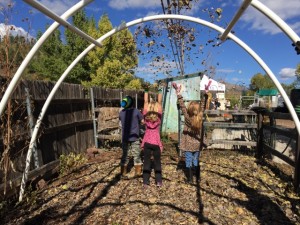
We will work them maybe an hour a week per class for a whole academic year, well maybe not a whole year from Sept – Nov and then pick up again in March until the end of the school year. Because it’s still cold outside. We grow food gardens with them.
There’s been a huge push in the world around pollinator gardens to support monarch butterflies and other pollinator species that have been in decline. We’ve been working with the local arboretum here to build pollinator gardens.
Do you want to explain to listeners what a pollinator garden is?
It will have native plants to the area known as pollinator species that provide nectar to pollinators, monarchs, bees, all of those pollinators. Because pollinators have been in decline, it’s all the more important and it’s a great way to teach students about pollination species and pollination period. It’s a great learning tool and there’s also a lot of funding for it now, so that always kind of helps!
The other thing we do, which I’m still learning how to do this, is to work with local hydrology and if there are erosion problems on the school grounds which there usually are! So TerraBIRDS works using a lot of permaculture techniques like building water basins and building swales.
And the idea is to make these landscapes more beautiful, more functional and low maintenance. Again schools are strapped and so they don’t have money to spend on great landscaping and to maintain great landscaping! So we work with the kids and we build swales and all these things, and they get to learn what a water shed really means and how their school fits into a broader water shed. And what water flow across their school really means and looks like and when that’s not managed well what can happen.
So there’s just a lot of different angles that we can approach these experiences with, so it kind of depends on what is already there. Cause it’s not just about growing food, but growing whatever, and just working with the land that is already there and taking advantage of all those opportunities and turning them into teachable moments.
So how many schools do you go to is it just one?
We have ten schools that are part of the district a couple of charter schools, Montessori schools, lots of elementary schools. So we work in all ten of the Flagstaff elementary schools. We’re working towards working in the other charter schools. We are focused on 3-5th grade – upper elementary. The educational standards curriculum with 4th grade makes sense with what we do, we work with all grades, but fourth is the focus.
My big question has been, gardens are big need a lot of work in the summer and school isn’t in session then? Can you tell us a little bit about dealing with that summer when kids are there?
Yep, and that’s always the questions and concern….
Questions and Concerns about Summertime
We do terra staff members do go out to schools and do some maintenance over the summer. The kids that go to these schools often live really close, so we really encourage the students to go to them. Beacuse often the gardens are in a place they can just go to them, because they are outside, they are not required to go to the school, so they can get through side gates, working on to bring that culture, still things happening over the summer and you can come by and you can harvest things from the garden that you helped start before you got out of school. So we really encourage kids to come with their parents, and the more people know what they are trying to do, learning continues with their parents, and it’s really great!
A lot of schools are not necessarily year round, but they’re only out 8 weeks, as opposed to 12 weeks when I was little. So it’s a pretty short period of time anymore. The charter school I worked with this past spring and past fall those parents at just a really tiny school and those parents are really involved. So we had a really involved group that was coming by and it was on a drip irrigation so the watering wasn’t so much of a problem.
We have a tremendous monsoon season that usually starts on July 4th, so that can be a problem too. We really just have to worry about June most of the time.
manageable in
Southern AZ
have the opposite gardening season
works with the academic year, so I feel like it’s pretty easy here too!
The Garden Starts program has been operating out of a greenhouse that is on the campus of Northern AZ University. We have a really good relationship with the community and the folks at NAU. But it’s a tenuous relationship they can decide they don’t want us in there. It obviously works as a program so we’ve been looking for a more permanent home, but we only operate for about 3 months in the greenhouse. So my undertaking in 2016 is exciting, we’re gonna do a lot of partnership building and grant writing and develop out a community greenhouse
garden starts program developing a lot of other needs across the community around growing indoors. Really exciting it’s gonna be a lot of work, but I’m really dedicated to the idea!
What does that mean that the greenhouse would be open all year round?
open to a lot of possibility, maybe having a fall CSA, or people coming to grow in the green houses to grow for restaurants or distribute subsidized veggies for low income individuals and yeah you can grow year round there’s a lot of ventilation needed, tricky but possible.
?Another guest was talking about growing tomatoes in the greenhouse. Richard Wiswell recommended growing them that way!
A favorite tool that you like to use? If you had to move and could only take one tool with you what would it be.
IDK what it’s called it’s called like a pitch fork but it’s broader and the tines are longer and it’s for aerating the soil.
I think it’s called a broad-fork?
A favorite recipe you like to cook from the garden?
I eat pretty simply, I love to cook, a good tomato on a Caprese salad is one of my favorite things in the world! Just tomatoes, salt, olive oil, and basil, and mozzarella cheese. A lot of restaurants add balsamic vinegar which I totally disagree with. That’s my favorite thing in the world to eat!
A favorite internet resource?
I probably spend just too much time looking at catalogs online. I’m always looking at seeds. I’ve looked for a lot of gardening blogs, I’ve never found one that I’m super excited about.
Johnny’s comes up a lot, but also there’s a great Peaceful Valley Organics that comes up a lot too!
A f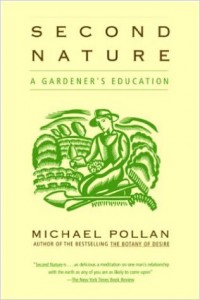 avorite reading material-book, mag, blog/website etc you can recommend?
avorite reading material-book, mag, blog/website etc you can recommend?
I really like Michael Pollens book Second Nature. It’s just beautiful.
If you have a business to you have any advice for our listeners about how to sell extra produce or get started in the industry?
In terms of CSA’s I think they are really great model, they can be done really well. The CSA works for places for Flagstaff but it might not be appropriate for everywhere. Non-profits are a great place to house educational programs. And Teaching people and keeping people how to learn how to grow their own seedlings and how to do their own gardening just great. Can only be effective at the local level, there’s not some national organization, to support on the ground. It think it’s up to the grassroots community and citizens to really spearhead that, it’s really important work.
I think understanding the need first and creating your solution around that. Because some people get a lot of really exciting ideas but they might not be the most important for their community. They’re very excited about the idea, and I think starting with the problem statement is the way to go!
Awesome advice! I think you hit the nail on the head. It’s good to think of the problem and be open to feedback, often a small pivot is all that’s needed you don’t have to give up the idea. And what you said about every community is different, that’s part of how we designed our government and schools is local control. Different things are gonna grow in different areas.
I would say one more thing about what Terra BIRDS brings to this school gardens. We are the continuity piece, with gardens what we’ve noticed that there will be a champion parent and a champion teacher, teachers move on, and parents as kids move up the grades, the kids aren’t there anymore and these gardens are just languishing until the next champion that comes along, what I feel is nice about at the Terra BIRDS and is very replicable in every community. They are a locally funded organizaiton that is working in the schools every year that is providing consistency and helping to build a culture in every school around taking care of these spaces! And I feel like it’s a really good way to do it. Because it doesn’t matter who comes and goes, everybody gets to experience that space that we’ve created together. We are providing a lot of the leadership to carry it forward into the years and bringing a lot of continuity. School gardens are so tough that was way without that permanent continutiy source it’s really hard to keep them going. I think there is a space in every community for a space for an organization like TerraBIRDS.
Final question-
If there was one change you would like to see to create a greener world what would it be? For example is there a charity or organization your passionate about or a project you would like to see put into action. What do you feel is the most crucial issue facing our planet in regards to the environment either in your local area or on a national or global scale?
There’s a lot of things I think need to happen! Without being too political I really wish we could all work together towards solutions for climate change and how that is going to impact what we are able to grow in the future! I see it as a really exciting challenge, but unfortunately that’s been mired down by people who say either it’s not happening or not because of humans! I just really hope that we can see it as a challenge that we need to take seriously but also bring creativity to!
Thinking of new ways of growing things and new ways of being but looking at it from a place of creativity and abundance. I feel like everybody should be getting on board and reaching out to low income communities and immigrant communities who have so much knowledge to bring to the table!
Do u have an inspiration tip or quote to help motivate our listeners to reach into that dirt and start their own garden?
I was just reading a quote this morning, on my box of tea. It says “In as many places as possible I will get my feet down to the earth.” Henry David Thoreau said that!
How do we connect with you?
They can contact me at grow@terrabirds.org and we welcome donations! You can edit that out.
No, I would encourage people to check it out and donate! A few of my guests have talked about how kids don’t know carrots grow in the ground or a potato and think all food comes from a grocery store and theres a huge disconnect.
One of my best guests was near you in New Mexico, David Salmon who talked about the native plants and the monarch butterfly. And how he started organics because he wanted to help his clients, not just teaching his employees but by making his clients successful using organic practices.
